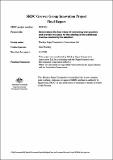| Abstract | The Cooperative Systems project (SRDC Project MSA003) considered how a cane quality incentive scheme might be incorporated into a cane payment. The report discussed the measurement and feedback of cane quality data to harvester operators and growers to ensure that the information delivered sends the right market signals and compensates the parties for the costs involved in achieving particular targets. A good example is extraneous matter. Extraneous matter can be reduced by simply increasing the fan speed on the harvester’s extractor. However this will also increase the loss of sound cane in the field, which is not the desired effect. Instead the harvester operator should slow down and adopt other “best practice” harvesting measures, but this will increase harvesting costs for no real benefit to the harvester. This project aimed at identifying the true costs of adopting Harvest Best Practice “HBP” and to provide the basis of a cane payment option to share the additional revenue and costs generated from HBP between the grower and harvester operators. This was to be achieved through the development of a web based cane loss indicator. This indicator would be used by growers and harvester operators to monitor the cane loss and harvester throughput and for agreement to be reached on payment options that would deliver the best results for the grower, miller and harvester operator. The project involved the installation of GPS tracking devices and associated equipment to harvesters that recorded the position of the harvester in the field as well as ground speed, direction and primary extractor speed. This data is then sent from the harvester tracking device to Mackay Sugar computer servers via the Telstra CDMA 1X mobile data network. Initially due to commence in the harvest season of 2005 the project was delayed for 12 months mostly due to concerns with the Telstra mobile network, however this was rectified in early 2006 and the project strated in the harvest season of 2006. Mackay Sugar consulted BSES staff and Gary Sandells (Harvest Solutions) to design and undertake suitable field trials to best measure cane loss through the most common primary extractor fans being utilised on a variety of cane harvesters. In all, nine trials were conducted to determine cane loss for the new 1500mm Cameco extractor fans and Vortex extractor fans being utilised in the later model Case cane harvesters. Cane loss, calculated by deducting the clean cane yield at the highest fan speed from the clean cane yield at the lowest fan speed, showed additional cane being delivered at the higher fan speeds in eight trials (in one trial there was a decrease of 14 t/ha). On average, an additional 13 t/ha of cane was delivered at the higher fan speeds. This additional cane delivery shows that generally there is no significant cane loss at higher fan speeds. Similar results have not been found before – traditionally, as the fan speed increases, so does cane loss. This set of harvest cane-loss trials has produced some unexpected results in terms of cane loss in relation to fan speed. Additional trial work needs to be completed to better understand the relationship between fan speeds and cane loss when using the new generation extractor fans. The initial aim of this work was to develop a web-based cane-loss indicator. This was to be done by combining the existing cane-loss work that was undertaken with the smaller, standard extractor fans and this new work with the larger extractor fans and the new vortex type extractors. As the results from this set of trials are contrary to previous work, it is not possible to use this data to produce a web-based cane-loss indicator. |

